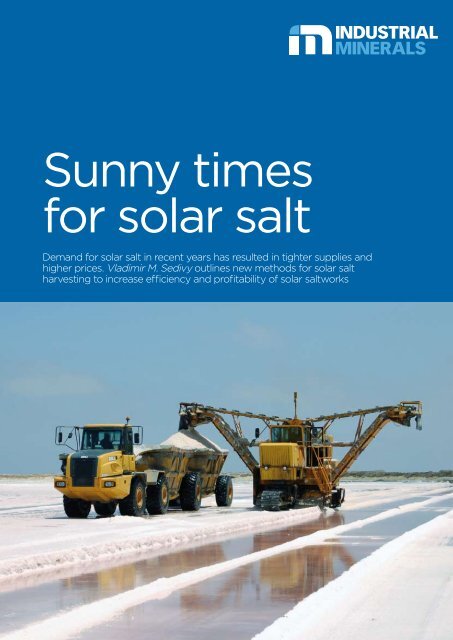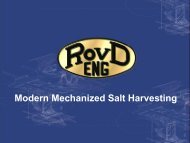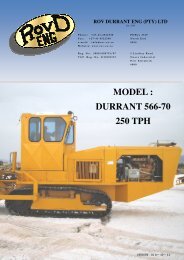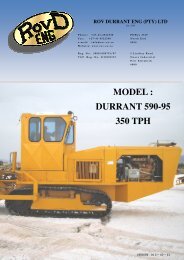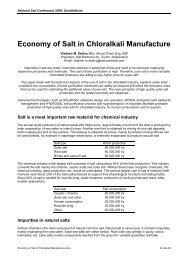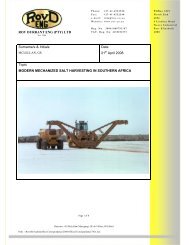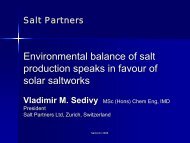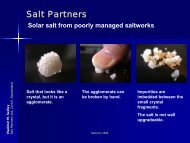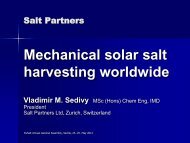Sunny times for solar salt
Sunny times for solar salt.pdf - ResearchGate
Sunny times for solar salt.pdf - ResearchGate
- No tags were found...
Create successful ePaper yourself
Turn your PDF publications into a flip-book with our unique Google optimized e-Paper software.
<strong>Sunny</strong> <strong>times</strong><br />
<strong>for</strong> <strong>solar</strong> <strong>salt</strong><br />
Demand <strong>for</strong> <strong>solar</strong> <strong>salt</strong> in recent years has resulted in tighter supplies and<br />
higher prices. Vladimir M. Sedivy outlines new methods <strong>for</strong> <strong>solar</strong> <strong>salt</strong><br />
harvesting to increase efficiency and profitability of <strong>solar</strong> <strong>salt</strong>works
Solar <strong>salt</strong><br />
In 2005, the annual world production of <strong>salt</strong><br />
exceeded 250 million tonnes <strong>for</strong> the first time.<br />
Since then, it has been fluctuating at around<br />
260 million tpa. Recent upturn in demand,<br />
driven by chemical markets in Asia and<br />
de-icing markets in Europe, resulted in<br />
shortage of high quality <strong>solar</strong> <strong>salt</strong>, tightening<br />
supply and sharply increasing prices.<br />
Forecast demand <strong>for</strong> <strong>salt</strong> in 2015 is 290-300<br />
million tpa. Approximately 40% of all <strong>salt</strong><br />
produced worldwide is manufactured by <strong>solar</strong><br />
evaporation of sea water and inland brines.<br />
The <strong>solar</strong> <strong>salt</strong> manufacturing method<br />
consists of evaporation of brines in a series of<br />
shallow ponds up to saturation, followed by<br />
further evaporation of saturated brine in<br />
crystallisers. Depending on the climatic<br />
conditions, the <strong>salt</strong> crystal layer that grows at<br />
the crystalliser bottom can become several<br />
centimetres thick in one year but under<br />
favourable climatic conditions the thickness<br />
can reach a few decimetres be<strong>for</strong>e it is<br />
harvested.<br />
There are many methods of crystallising and<br />
harvesting <strong>solar</strong> <strong>salt</strong>:<br />
• Salt crystals can grow on <strong>salt</strong> floor or on<br />
mud floor;<br />
• The crystallisers can receive preconcentrated<br />
brine in series or in parallel;<br />
• The <strong>salt</strong> can grow as a compact layer or the<br />
crystals can be kept apart by regular raking;<br />
• The brine level can be maintained deep or<br />
shallow;<br />
• Thick or thin <strong>salt</strong> layer can finally be<br />
harvested.<br />
Solar <strong>salt</strong> harvesting<br />
There are many combinations of <strong>salt</strong><br />
production and harvesting methods. In many<br />
parts of the world, <strong>for</strong> example in Africa,<br />
the most primitive <strong>salt</strong> harvesting method –<br />
Table 1: Worldwide production of <strong>salt</strong>,<br />
by type (million tpa)<br />
Salt type<br />
World production<br />
(tpa)<br />
Solar <strong>salt</strong> 100<br />
Rock <strong>salt</strong> 80<br />
Brines and vacuum <strong>salt</strong> 80<br />
Total 260<br />
Spotlight on Salt Partners<br />
Salt Partners are independent<br />
consultants and engineers active in the<br />
field of <strong>salt</strong> and chloralkali production,<br />
<strong>salt</strong> processing and hypersaline<br />
biotechnology. Salt Partners’<br />
worldwide reputation is based on 40<br />
years of experience gained in projects<br />
implemented worldwide.<br />
Durrant 566-70 <strong>salt</strong> harvester collecting <strong>salt</strong> <strong>for</strong> the first time by the client’s driver under the<br />
supervision of the ROV Durrant commissioning engineer.<br />
by bare hand – is still being practised today.<br />
Elsewhere, the <strong>salt</strong> harvesting methods<br />
invented long ago <strong>for</strong> example in ancient<br />
Rome or by the Arabs, are being practised. In<br />
India or in China, regular raking of <strong>salt</strong><br />
crystals in shallow ponds allows manual<br />
harvesting of thicker <strong>salt</strong> layers.<br />
Salt grown on the <strong>salt</strong> floor as a compact<br />
thick <strong>salt</strong> layer is usually of better quality.<br />
However, such <strong>salt</strong> must be harvested with<br />
mechanical machinery. The productivity of<br />
mechanised <strong>salt</strong>works is higher, the<br />
production cost lower and the <strong>salt</strong> product is<br />
more competitive. The trend towards<br />
mechanisation of <strong>solar</strong> <strong>salt</strong>works is prevailing<br />
worldwide.<br />
Mechanical <strong>salt</strong> harvesting<br />
Mechanical <strong>salt</strong> harvesting has been employed<br />
by <strong>solar</strong> <strong>salt</strong>works in a variety of <strong>for</strong>ms,<br />
including simple power-enhanced devices,<br />
standard construction machinery – such as<br />
mechanical shovels and front end loaders –<br />
and purpose-built <strong>salt</strong> harvesters.<br />
Perhaps one of the simplest mechanical<br />
devices used in <strong>solar</strong> <strong>salt</strong>works is a wooden or<br />
steel plate with handles connected to a wrench<br />
of a tractor, which provides the pulling power.<br />
The workers drag the device away from the<br />
tractor to the far end of the crystalliser, lower<br />
it to the <strong>salt</strong> and then, when the tractor starts<br />
pulling, balance the plate so that the <strong>salt</strong> gets<br />
dozed to the side of the crystallising pond<br />
where the tractor is standing. Productivity of<br />
such devices is low and the people using them<br />
must work day and night to earn the cost of<br />
ROV Durrant Engineering<br />
living and the diesel fuel they consume.<br />
In many smaller mechanised <strong>salt</strong>works,<br />
standard construction machinery is being<br />
employed <strong>for</strong> harvesting. This may include,<br />
<strong>for</strong> example, front end loaders, graders,<br />
mechanical shovels, and tractor-scrapers.<br />
Usually, the <strong>salt</strong> layer is first ripped<br />
(scarified) to separate the <strong>salt</strong> crystals from<br />
each other. Various devices are used <strong>for</strong> this<br />
task, including simple hooks or rotating<br />
cutters. The loosened <strong>salt</strong> layer can then be<br />
collected with excavators fitted with wide<br />
shovels onto heaps. The same excavators, but<br />
fitted with high volume buckets, then transfer<br />
the <strong>salt</strong> from the heaps to trucks, trailers or<br />
dumpers, which transport the <strong>salt</strong> from the<br />
crystallisers to the washplant.<br />
Much depends on the hardness of the <strong>salt</strong><br />
layer and the bearing capacity of the<br />
crystalliser floor. A soft <strong>salt</strong> layer on a hard<br />
floor can be collected with tractor-scrapers<br />
and transported to the washplant in a single<br />
working cycle. Salt grown on a hard<br />
crystalliser floor can be cut with front-end<br />
loader buckets that have been equipped with a<br />
special cutting edge. The same front end<br />
loaders then lift the <strong>salt</strong> and fill the trucks.<br />
For higher capacity, the <strong>salt</strong> is windrowed<br />
with graders and the <strong>salt</strong> is collected with<br />
harvesters that lift the <strong>salt</strong> to trucks. After the<br />
harvest, the crystalliser floor must be prepared<br />
<strong>for</strong> the next crystallisation cycle.<br />
Solar <strong>salt</strong> harvesters<br />
There are many types of <strong>salt</strong> harvesters. They<br />
vary in capacity, in ground pressure, whether<br />
April 2012
Solar <strong>salt</strong><br />
they cut the <strong>salt</strong> layer or just collect it, etc.<br />
The main types are:<br />
• Tractor drawn or self-propelled;<br />
• On wheels or on Caterpillar tracks;<br />
• Driving on <strong>salt</strong> bed or on crystalliser floor;<br />
• Lifting or cutting the <strong>salt</strong> layer;<br />
• Cutting the <strong>salt</strong> layer upwards or<br />
downwards;<br />
• Discharging onto belt conveyors or into<br />
trailers.<br />
Tractor-drawn harvesters are usually made<br />
<strong>for</strong> smaller capacities. Their <strong>salt</strong> lifting gear<br />
can be propelled from the tractor drive shaft<br />
or they can have their own engines.<br />
Wheeled <strong>salt</strong> harvesters are usually suitable<br />
only <strong>for</strong> crystallisers with a permanent hard<br />
<strong>salt</strong> floor. For higher capacities and <strong>for</strong><br />
harvesting of <strong>salt</strong> grown on mud floors, only<br />
harvesters on Caterpillar tracks can be<br />
employed successfully. This is particularly the<br />
case when the harvester should separate the<br />
<strong>salt</strong> layer from the floor, because this task<br />
requires pushing. The pushing power can be<br />
best transmitted to the crystalliser floor by the<br />
Caterpillar tracks.<br />
Unless the <strong>salt</strong> harvesters are excessively<br />
heavy, the ground pressure exercised by the<br />
Caterpillar tracks to the ground can be as low<br />
as the pressure of the human foot. This makes<br />
it possible <strong>for</strong> the harvester to drive even on<br />
the mud floor and lift the <strong>salt</strong> layer in the<br />
front, provided that the <strong>salt</strong> layer is not too<br />
hard and disintegrates on the lifting blade.<br />
The configuration of such harvesters works<br />
successfully within a given set of parameters,<br />
such as the mud floor bearing capacity,<br />
thickness and hardness of the <strong>salt</strong>, harvester<br />
width, weight, power, etc. If some parameters<br />
change with time, or if such harvesters should<br />
be employed in some other <strong>salt</strong>works, the<br />
harvester may fail.<br />
It is safer to design the harvesters so that<br />
they drive on the <strong>salt</strong> layer. Then they can be<br />
employed even in <strong>salt</strong>works built on very soft<br />
ground. Some such machines harvest the <strong>salt</strong><br />
on the side.<br />
Usually, the elevation of the lifting blade is<br />
controlled by a worker, either sitting in a<br />
cabin with good view of the lifting blade or<br />
walking along the harvester. Such<br />
configuration limits the width of the<br />
In Tuticorin, India, perhaps the simplest method of <strong>salt</strong> harvesting with wooden tools from shallow<br />
earthen ponds is being practised. A similar <strong>salt</strong> harvesting method is still being used in small<br />
<strong>salt</strong>works all around the world.<br />
A team of men pick the <strong>salt</strong> from the mud floor of a crystalliser by shovels to suspended belt<br />
conveyors, which transport the <strong>salt</strong> to a slurring vessel located on a tractor. Salt is mixed with brine<br />
and pumped to a mobile washplant located at the side of the crystallising pond.<br />
Salt Partners Ltd<br />
Salt Partners Ltd<br />
harvesting path to approximately one metre.<br />
Placing the harvesting element behind the<br />
harvester facilitates a much wider harvesting<br />
path.<br />
Typically, the harvesting element is 2.5<br />
metres wide so that the harvester does not<br />
exceed the width of vehicles normally<br />
permitted <strong>for</strong> road traffic. Wider harvesters<br />
would require special transport should they be<br />
moved from one place to another on public<br />
roads.<br />
Salt grown on <strong>salt</strong> has the advantage of<br />
minimised contamination with insoluble<br />
material originating from the crystalliser<br />
bottom. However, the new <strong>salt</strong> layer is firmly<br />
attached to the permanent <strong>salt</strong> floor. Unless<br />
the new <strong>salt</strong> layer is very soft, it cannot be<br />
lifted – it must be cut. This can be done either<br />
separately (ripping, scarifying), prior to<br />
windrowing, collecting and lifting the <strong>salt</strong> to<br />
the trucks, or in one working operation.<br />
Time, fuel and manpower can be saved if<br />
these operations are per<strong>for</strong>med together by a<br />
single machine.<br />
Simple ripping of the <strong>salt</strong> frequently results<br />
in large <strong>salt</strong> lumps, or blocks, being <strong>for</strong>med.<br />
Hard <strong>salt</strong> lumps cause problems in the<br />
washplant. Cutting of the <strong>salt</strong> layer is possible<br />
with rotary devices, which prevent the<br />
<strong>for</strong>mation of lumps.<br />
The rotation can be done either from top to<br />
the bottom or vice versa. If the cutting is done<br />
from the top to the bottom, then the <strong>salt</strong> is<br />
thrown behind the rotary device. There<strong>for</strong>e,<br />
behind the cutting drum a blade must be<br />
provided, followed by a cover that facilitates<br />
collection of the cut <strong>salt</strong> to a lifting device.<br />
Salt slipping below the blade, remaining on<br />
the floor, can represent significant harvesting<br />
April 2012
Solar <strong>salt</strong><br />
harvest will separate the new <strong>salt</strong> layer from<br />
the crystalliser floor precisely at the correct<br />
elevation. When <strong>salt</strong> is grown on mud floor,<br />
the contamination of <strong>salt</strong> with insolubles will<br />
be minimised. When <strong>salt</strong> is grown on <strong>salt</strong>, the<br />
floor is maintained clean and ready <strong>for</strong> the<br />
next crystallisation cycle.<br />
In Mexico, <strong>salt</strong> is grown on a <strong>salt</strong> floor. The <strong>salt</strong> layer is first ripped, then windrowed. The windrow is<br />
collected by a tractor-pulled harvester, which lifts the <strong>salt</strong> to a truck-pulled hopper-trailer equipped<br />
with bottom discharge gates.<br />
loss. Besides, cutting elements that enter the<br />
<strong>salt</strong> layer from the top to the bottom cause a<br />
breakage of the <strong>salt</strong> crystals and create<br />
undesired fines.<br />
Cutting of the <strong>salt</strong> layer from the bottom to<br />
the top, in the direction of harvester<br />
movement, lifts the <strong>salt</strong> layer and separates the<br />
crystals, minimising their breakage. The<br />
crystalliser floor is swept clean of <strong>salt</strong>. When<br />
the cutting elevation is effectively controlled,<br />
the crystalliser floor behind the harvester is<br />
ready to receive brine <strong>for</strong> the next<br />
crystallisation cycle.<br />
Laser control of earth-moving machinery is<br />
an established practice, <strong>for</strong> example in road<br />
construction. In <strong>salt</strong> harvesting, the laser<br />
Salt Partners Ltd<br />
control is less common. In principle, a<br />
rotating laser beam marks a perfectly<br />
horizontal plane, <strong>for</strong> example four metres<br />
above the <strong>salt</strong> crystalliser. The harvester is<br />
equipped with a receiver reaching out above<br />
the harvester roof. The harvester is equipped<br />
with devices that measure and control the<br />
distance between the receiving point of the<br />
laser signal and the lowest point of the cutting<br />
drum. Should this device indicate that the<br />
distance is increasing, the controls of the<br />
cutting drum lift it to the desired level, and<br />
vice versa.<br />
Thus, the crystalliser floor needs to be<br />
levelled only once, whether by some other<br />
equipment or by the harvester itself. The next<br />
ROV Durrant <strong>salt</strong> harvesters<br />
Salt Partners avail of more than 40 years of<br />
experience in <strong>solar</strong> <strong>salt</strong> production and<br />
processing. In search <strong>for</strong> equipment most<br />
suitable <strong>for</strong> <strong>solar</strong> <strong>salt</strong> production, the <strong>solar</strong> <strong>salt</strong><br />
harvesters made by ROV Durrant have been<br />
determined to fulfil the requirements <strong>for</strong><br />
versatile deployment under varying<br />
conditions.<br />
ROV Durrant Engineering, based in Port<br />
Elizabeth, South Africa, made its first <strong>salt</strong><br />
harvesters in 1964. The first machine was<br />
capable of harvesting 80 tph of <strong>solar</strong> <strong>salt</strong>. Its<br />
designation was SH80 (Salt Harvester 80<br />
tph). Later, it was recognised that the same<br />
machine could per<strong>for</strong>m differently, depending<br />
on the properties of the <strong>salt</strong>. There<strong>for</strong>e, the<br />
type designation was changed. Today, this<br />
machine bears the type designation Durrant<br />
130-60.<br />
Over the years, larger machines were<br />
designed, the output increased and reached<br />
1,000 tph with the type Durrant 916-120.<br />
Presently, the most popular size of the<br />
Durrant <strong>salt</strong> harvesters is in the middle of this<br />
range. Recently, ROV Durrant supplied type<br />
Durrant 560-75, Durrant 590-95 and<br />
Durrant 790-100 <strong>salt</strong> harvesters to <strong>solar</strong> <strong>salt</strong><br />
producers in Turkey, the Middle East and<br />
India.<br />
Salt Partners Ltd<br />
Collecting and lifting <strong>salt</strong> harvester on double wheels. The wheels on the left hand side drive on the <strong>salt</strong> floor of the crystalliser. The wheels on the right<br />
hand side drive on the <strong>salt</strong> layer. Observe that the wheels on the right hand side are somewhat higher up. There<strong>for</strong>e the harvester collects the <strong>salt</strong> on the<br />
left hand side deeper than on the right hand side.<br />
April 2012
Solar <strong>salt</strong><br />
Table 2: ROV Durrant chassis types<br />
Chassis type Harvesting capacity (tph)<br />
Type 1 50-100<br />
Type 3 100-200<br />
Type 5 200-400<br />
Type 7 400-600<br />
Type 9 600-1,000<br />
The type designation, <strong>for</strong> example Durrant<br />
590-95, signifies the following:<br />
• 5 is the type of the harvester chassis;<br />
• 90 is the size of the engine, 9.0 litres;<br />
• 95 is the diameter of the cutting drum (pick<br />
roll) in centimetres. 95 cm pick roll is<br />
designed to cut a <strong>salt</strong> layer 30 cm deep and<br />
fling it to the elevator.<br />
In the Durrant 590-95 configuration, the<br />
harvesters have an instantaneous harvesting<br />
capacity of 200 m 3 /h of the <strong>salt</strong> layer,<br />
corresponding to approximately 350 tph of<br />
bulk <strong>salt</strong>. Depending on turn-around <strong>times</strong>,<br />
waiting <strong>for</strong> trailers and operator breaks, the<br />
effective harvesting rate is somewhat lower.<br />
With mobile belt conveyors and mobile lorry<br />
loading hoppers, about 80% of the<br />
instantaneous harvesting capacity is<br />
achievable.<br />
ROV Durrant’s range of <strong>salt</strong> harvesters is<br />
based on the chassis types in Table 2.<br />
Mounted on the chassis are the engines,<br />
hydraulic pumps, Caterpillar tracks, the pick<br />
roll, the elevator and the cabin <strong>for</strong> the driver.<br />
Unlike other systems, the Durrant <strong>salt</strong><br />
harvesters per<strong>for</strong>m all the required harvesting<br />
operations combined:<br />
Salt Partners Ltd<br />
Salt harvester on Caterpillar trucks drives on the mud floor of the crystallising pond. It pushes a<br />
blade between the <strong>salt</strong> layer and the mud, lifting the <strong>salt</strong> layer, which disintegrates on the blade. The<br />
<strong>salt</strong> falls from the blade to a rotating device, which lifts the <strong>salt</strong> to a belt conveyor.<br />
Salt Partners Ltd<br />
On request of the client, this type Durrant 916‐120F harvester has the driver’s cabin located at the<br />
front, with the pick roll and the conveyor just behind it. The harvester drives on Caterpillar trucks<br />
only on the crystalliser floor. Also this harvester is laser controlled.<br />
• The pick roll cuts the <strong>salt</strong> and flings it to the<br />
elevator;<br />
• The elevator lifts the <strong>salt</strong> to trucks, trailers<br />
or to mobile belt conveyors;<br />
• The harvester maintains the crystalliser floor<br />
perfectly levelled <strong>for</strong> the next crystallisation<br />
cycle.<br />
No separate ripping, windrowing, lifting<br />
and crystalliser floor maintenance after the<br />
<strong>salt</strong> harvest is required.<br />
The harvesters travel on the <strong>salt</strong> layer and<br />
cut the <strong>salt</strong> behind them. The ground pressure<br />
is similar to the pressure exerted by a human<br />
foot; there<strong>for</strong>e, the harvesters can be used in<br />
crystallisers growing <strong>salt</strong> on soft mud as well<br />
as on a hard <strong>salt</strong> floor.<br />
The pick roll arrangement prevents<br />
collection of unbroken <strong>salt</strong> lumps and<br />
<strong>for</strong>mation of fines. The level of the cutting<br />
drum is laser controlled, which facilitates<br />
maximum <strong>salt</strong> recovery and minimises <strong>salt</strong><br />
contamination with impurities. After the <strong>salt</strong><br />
harvest, the crystalliser floor is perfectly<br />
levelled and ready to receive brine <strong>for</strong> the next<br />
crystallisation cycle.<br />
The Durrant <strong>salt</strong> harvesters are designed to<br />
significantly improve the productivity of <strong>solar</strong><br />
<strong>salt</strong>works and profitability of the <strong>salt</strong><br />
production and exports.<br />
References:<br />
1. Salt harvesters of Ghana. 2007. A film by<br />
Marcia Rock on YouTube.<br />
2. P. de Flers, B. de Saboulin, J. Clain. 1973.<br />
Harvest of <strong>solar</strong> <strong>salt</strong> at Salin de Giraud France,<br />
Fourth International Symposium on Salt.<br />
3. Gavin McLellan. 2008. Modern mechanised<br />
<strong>salt</strong> harvesting in southern Africa, Proceedings<br />
of the National Salt Conference,<br />
Gandhidham, India.<br />
4. Vladimir M. Sedivy. 2010. Mechanical <strong>solar</strong><br />
<strong>salt</strong> harvesting worldwide, Proceedings of the<br />
International Salt Summit, Ahmedabad,<br />
India.<br />
Contributor: Vladimir M. Sedivy, President,<br />
Salt Partners Ltd.<br />
vladimir.m.sedivy@<strong>salt</strong>-partners.com.<br />
Vladimir Sedivy received his MSc degree in<br />
chemical engineering at the University of<br />
Prague. His interest in <strong>salt</strong> started in 1973<br />
when he became a manager of <strong>salt</strong> projects in<br />
Africa and South America. He invented the<br />
HYDROSAL <strong>salt</strong> purification process with<br />
hydroextraction of impurities in 1978. As<br />
director of Krebs Swiss, he developed and<br />
implemented more than 30 <strong>salt</strong> and<br />
chloralkali projects in Europe, Africa, Middle<br />
East and India. In 2003, he established Salt<br />
Partners. Since then, Salt Partners have built<br />
several <strong>salt</strong> plants and carried out consultancy<br />
assignments <strong>for</strong> banks and government<br />
organisations worldwide. Salt Partners<br />
represent ROV Durrant in Europe, India and<br />
in the US.<br />
April 2012


